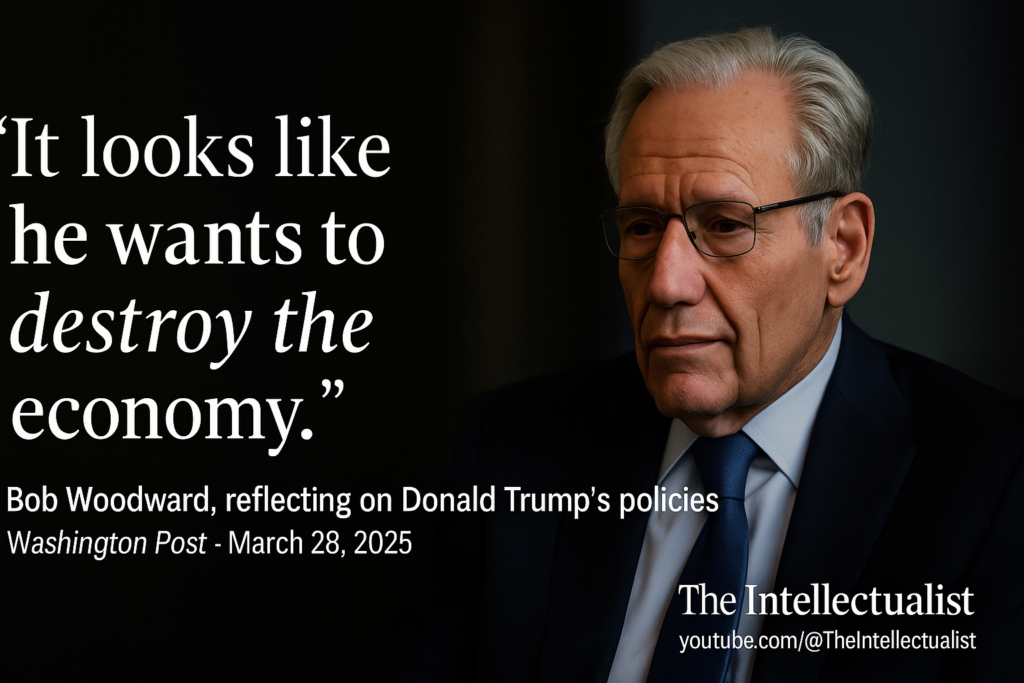Bob Woodward on Donald Trump: “It looks like he wants to destroy the economy.”

A Warning from Watergate: Woodward Returns
Doctrine of Destruction: Trump’s Economic Endgame
Trade as Target: The Infrastructure of Influence
Trade isn’t just policy. It’s infrastructure. It supports tens of millions of American jobs—in agriculture, energy, logistics, shipping, and tech. It links our prosperity to our influence. It binds us to our allies and keeps autocracies in check. To declare “trade is bad” is to reject not just globalization—but interdependence itself.
Some will say Trump was simply pursuing tough-love trade policy. That tariffs are leverage, not ideology. But leverage isn’t wielded with a sledgehammer. And real strategy doesn’t end in isolation.
In the months after that Oval Office confrontation, Trump imposed tariffs on steel and aluminum. The world responded in kind. Canada, the EU, and China hit back with retaliatory tariffs. American soybeans sat rotting in silos. Machinery costs rose. Farm bankruptcies spiked. The Federal Reserve estimated that more than 300,000 jobs were lost before the pandemic ever arrived.
We’ve seen what happens when leaders conflate nationalism with economic retreat. From Smoot-Hawley in the 1930s to Brexit today, the cost is never abstract. It’s supply chains broken, prices inflated, trust shattered.
The Adults Are Gone: Power Without Restraint
And now in 2025, Trump is back—with the same obsessions, but fewer obstacles. Gone are the generals, the technocrats, the adult supervision. There’s no Gary Cohn to push back. No General Mattis to walk. No John Kelly to stall the damage. Trump has surrounded himself with enablers, not advisors. And according to Woodward, that’s by design.
“Four years of not being president,” Woodward said, “gave him time to load the ammunition.” Now he’s using executive orders to remake the government in his image. Faster. Deeper. Without dissent.
Undoing Watergate: Institutional Erosion by Design
But Trump isn’t just targeting trade. He’s erasing the very structures designed to restrain him.
After Nixon’s resignation, Congress created a series of post-Watergate reforms: 10-year terms for FBI Directors. Permanent inspectors general in federal agencies. Stricter campaign finance limits. All meant to reduce corruption and restore public trust.
Trump has dismantled them.
He’s fired or neutered inspectors general. He’s used PACs to bypass campaign finance laws. He’s tried to fire the head of the Office of Government Ethics. What Nixon’s fall inspired—Trump’s rise has undone.
Real power, Trump once told Woodward, is fear. It’s not a theory. It’s a tactic. He governs by intimidation. Legislators. Bureaucrats. Media. Even markets. Fear isn’t just a weapon—it’s the currency of his administration.
The Blueprint Is Clear: Institutions Don’t Hold Themselves
And the press is in the crosshairs.
Trump still calls journalists “the enemy of the people.” Still smears outlets like the Post and CNN as “fake news.” But Woodward reminds us: the First Amendment still stands—for now. “The Constitution,” he said, “isn’t a guardrail. It’s an absolute.” It can hold. But only if we make it hold.
This time, Trump’s vision is clearer. Economic disruption is not collateral damage. It’s an objective. And his actions reveal a consistent goal: to extract the United States from the global framework that once made it powerful, prosperous, and central to international stability.
When the world’s largest economy turns inward, it doesn’t just create uncertainty. It invites vacuum—and with it, chaos.
Woodward’s insight isn’t just that Trump governs by assertion. It’s that he rejects the very premise of shared prosperity. To him, compromise is weakness. Treaties are traps. Interdependence is surrender. And trade—essential, stabilizing, inevitable trade—is poison.
There is a pattern here. Undermine institutions. Remove constraints. Rewrite rules. Then claim the results as destiny.
Woodward’s great strength isn’t in punditry. It’s in pattern recognition. He sees how power accumulates and corrodes. And in Trump’s second term, he sees something worse than recklessness. He sees intent.
When he says, “Everything is mine,” as he once told Woodward on tape, it’s not metaphor. It’s policy. It’s mindset. It’s motive.
If history teaches anything, it’s that institutions can hold—when people choose to make them hold. But they don’t survive sabotage passively. Not from within. And certainly not from the top.
It’s happening again.
This time, we’ve seen the blueprint.

